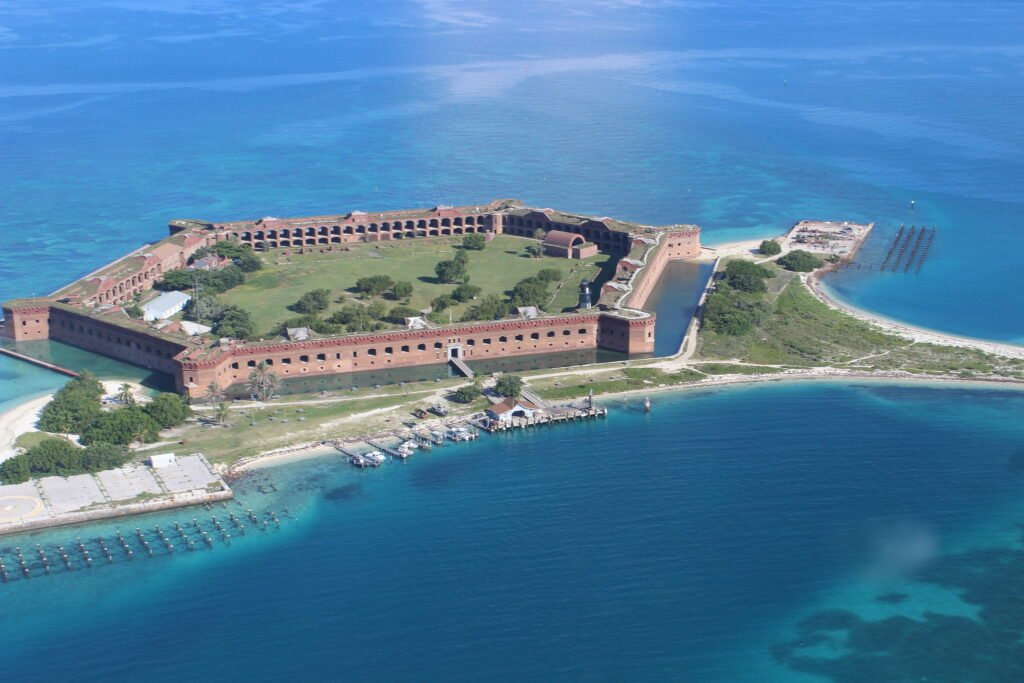Discover the rich history, diverse wildlife, and exciting activities of Dry Tortugas National Park in Florida. Plan your visit to this hidden gem, learn about conservation efforts, and explore tips for an unforgettable adventure.
Table of Contents
Introduction to Dry Tortugas National Park
Located about 70 miles west of Key West, Florida, Dry Tortugas National Park is a secluded paradise that offers visitors a unique blend of history, wildlife, and outdoor activities. This remote national park, accessible only by boat or seaplane, encompasses seven small islands and the impressive Fort Jefferson. Known for its crystal-clear waters, vibrant coral reefs, and rich marine life, Dry Tortugas is a must-visit destination for nature lovers and history buffs alike.
History and Background
Dry Tortugas National Park is steeped in history, with its most notable landmark being Fort Jefferson. Construction of the fort began in 1846 to protect one of the most strategic deepwater anchorages in North America. Despite its unfinished state, Fort Jefferson played a crucial role during the Civil War and later served as a prison. The park was designated as a national monument in 1935 and later became a national park in 1992, preserving its historical and natural significance.
Biodiversity at Dry Tortugas
The biodiversity of Dry Tortugas National Park is astounding. The park’s waters are teeming with marine life, including colorful coral reefs, sea turtles, and numerous fish species. Birdwatchers flock to the park to see over 300 bird species, making it a premier spot for ornithology enthusiasts. The islands provide critical nesting grounds for seabirds, including the sooty tern and brown noddy. The park’s unique ecosystem offers a sanctuary for both terrestrial and marine species, showcasing the importance of conservation.
Famous Attractions in Dry Tortugas
The most famous attraction in Dry Tortugas National Park is Fort Jefferson. This massive coastal fortress is one of the largest brick masonry structures in the Americas and offers visitors a glimpse into 19th-century military architecture. The park’s pristine beaches, such as Garden Key Beach, are perfect for sunbathing and picnicking. The coral reefs around Loggerhead Key are renowned for snorkeling and diving, providing a close-up view of the vibrant underwater world.
Activities to Enjoy
Dry Tortugas National Park offers a variety of activities for visitors. Snorkeling and diving are among the top attractions, allowing visitors to explore the underwater beauty of the coral reefs. Kayaking around the islands provides a serene way to experience the park’s natural splendor. History enthusiasts can take guided tours of Fort Jefferson to learn about its historical significance. Birdwatching, swimming, and camping on Garden Key are also popular activities that provide a full immersion in the park’s unique environment.
Accommodations in and around Dry Tortugas
While there are no hotels or lodges within Dry Tortugas National Park, camping on Garden Key offers a unique way to experience the park overnight. Campers should come fully prepared, as there are no services on the island. For those seeking more comfort, accommodations are available in Key West, where visitors can find a range of hotels, guesthouses, and vacation rentals. Staying in Key West allows easy access to ferry and seaplane services that transport visitors to the park.
Weather Conditions
The weather in Dry Tortugas National Park is typically warm and sunny, with temperatures ranging from the mid-60 degrees F in winter to the high 80 degrees F in summer. The dry season, from November to April, is the best time to visit, offering pleasant temperatures and minimal rainfall. The wet season, from May to October, can bring heavy rains and the risk of hurricanes. Visitors should always check the weather forecast and be prepared for changing conditions.
Tips for Visiting Dry Tortugas
When planning a visit to Dry Tortugas National Park, it’s important to book transportation in advance, as ferry and seaplane services can fill up quickly. Bring plenty of water, food, and sun protection, as there are no stores or shade on the islands. Pack snorkeling gear if you plan to explore the reefs, although rentals are available. Respect the park’s regulations to preserve its natural and historical resources, and always practice Leave No Trace principles.
Visitor Information
Dry Tortugas National Park is open year-round, with daily ferry and seaplane services from Key West. The entrance fee includes transportation and a guided tour of Fort Jefferson. Visitors should plan to arrive early to make the most of their day, as the journey to the park takes approximately 2.5 hours by ferry.
Conservation Efforts
Conservation is a top priority at Dry Tortugas National Park. The park’s fragile ecosystems, including its coral reefs and bird nesting sites, require ongoing protection. The National Park Service works to preserve these environments through research, habitat restoration, and visitor education. Efforts include monitoring marine life populations, controlling invasive species, and promoting sustainable tourism practices. Visitors can contribute by following park guidelines and supporting conservation initiatives.
For more information about Dry Tortugas National Park, Click here to visit the National Park Service website.
Dry Tortugas National Park is a captivating destination that offers a blend of history, natural beauty, and adventure. From exploring the historic Fort Jefferson to snorkeling in the vibrant coral reefs, there’s something for everyone in this remote paradise. Whether you’re a history enthusiast, a nature lover, or an adventure seeker, Dry Tortugas provides an unforgettable experience. Plan your visit today to discover the hidden gem of Florida and contribute to its preservation for future generations.







